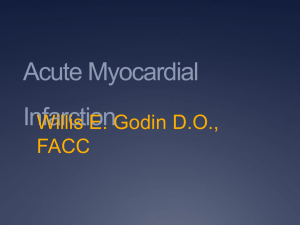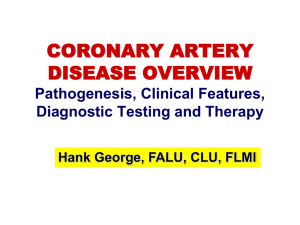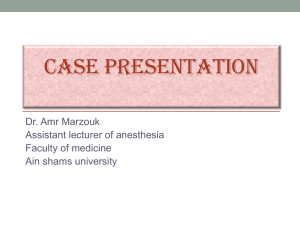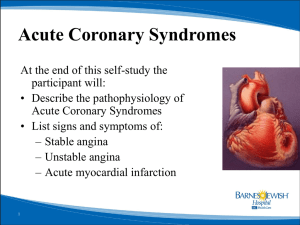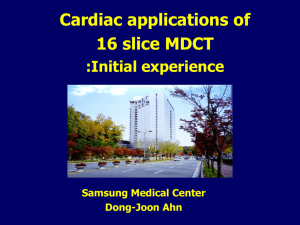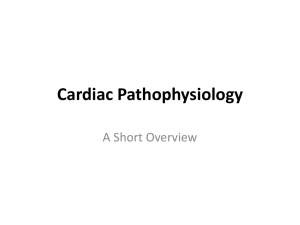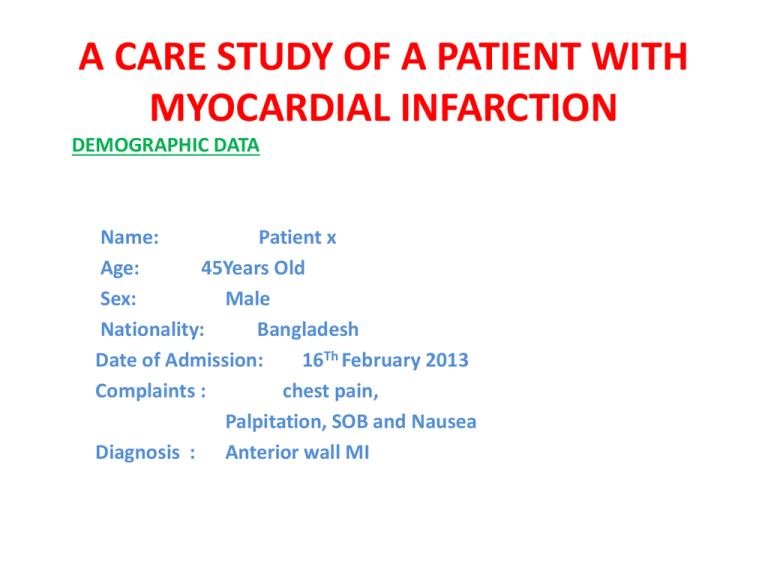
A CARE STUDY OF A PATIENT WITH
MYOCARDIAL INFARCTION
DEMOGRAPHIC DATA
Name:
Patient x
Age:
45Years Old
Sex:
Male
Nationality:
Bangladesh
Date of Admission:
16Th February 2013
Complaints :
chest pain,
Palpitation, SOB and Nausea
Diagnosis : Anterior wall MI
PHYSICAL ASSESSMENT
•
•
•
•
•
•
•
•
•
•
•
•
•
•
•
•
•
•
•
•
General appearance
Patient is looking anxious, restless and orient
Vital signs
T-36.4 c
HR-102/ Mt
R-30 / MT
B P-100/80 mm hg
SPO2-95 % in room air
SKIN
Cold, pale and diaphoretic
HEAD
Scalp is normal, hair is black
EYES
No redness, sclera white and clear, pupils reactive to light
NOSE
Nasal discharge present, nasal septum straight
MOUTH
Dry mouth and lips, no gum bleeding
NECK
No palpable lymph nodes
•
•
•
•
•
•
•
•
•
•
•
•
•
•
•
•
•
•
•
•
•
CHEST
Bilateral chest movement present
Tachypnea noted
No crackles, no wheezing
HEART
Tachycardia notes
No murmur
ABDOMEN
Soft to palpate
Positive bowel sound
Slight abdominal distention
GENITALIA
No palpable mass
Urethral meatus located ventrally on the end of the penis
EXTRIMITIES
Full range of motion present
Ten fingers and 10 toes present
PATIENT HISTORY
Past medical history
No past medical history of DM, HTN, IHD etc.
Patient is a known chronic smoker for more than 10 years
• Present medical history
• Patient X brought to ER by SRC ambulance with the
complaints of chest pain radiating to left arm, chest
discomfort, palpitation, SOB, and nausea. Received in ER
resuscitation room by stretcher.PT is conscious, oriented,
pale and diaphoretic .Vitals checked and recorded .Attached
to monitor, started oxygen via face mask 3 l/MT .Seen and
examined by ER doctor on duty and cardiologist. ECG done
and seen. Tab. ASPIRIN 300 MG , Tab PLAVIX 300 MG , Tab
atorvastatin 80 mg , Inj. MORPHINE 5mg ,IV , Inj. Ranitidine
50 MG IV , Inj. PREMOSAN 10 mg iv , NTG PUFF X 2 times s/ l ,
Inj. CLEXINE 40 mg s/c given as per order. For lab
investigations CBC, PT, APTT, ELECTROLYTES, RBS, BUN,
CREATININE, CK, CKMB, TROPONIN I QUANTITATIVE sent to
lab. Patient is admitted in ccu for further management.
•
SURGICAL HISTORY
• Patient x has no past and present surgical history.
• TOPIC PRESENTATIONS
Myocardial infarction or heart attack is the death
or damage of part of the heart muscles
(myocardium) because the supply of blood to
the heart muscle is severely reduced or
stopped. This is most commonly due to
blockage of a coronary artery following the
rupture of a vulnerable atherosclerotic plaque.
• ANATOMY AND PHYSIOLOGY OF THE HEART
• The heart is a roughly cone – shaped hollow
muscular organ. It is about 10 cm long and is
about the size of the owners fist .It weighs
about 225 g in women and heavier in men
about 310 g.
POSITION
The heart lies in the thoracic cavity the mediastinum between
the lungs. It lies obliquely, a little more to the left than the
right, and presents a bas above ,and an apex below. The apex
extends to the level of the 5th intercostal space and the base
extends to the level of the 2 nd rib
ORGANS ASSOCIATED WITH THE HEART
• Inferiorly:
The apex rest on the central tendon of the
diaphragm
• Superiorly: The great blood vessel, (the aorta, superior vena
cava, pulmonary artery, and pulmonary veins)
• Posteriorly: The esophagus, trachea, left and right bronchus,
descending aorta, inferior vena cava and thoracic vertebrae
• Laterally:
The lungs the left lung overlaps the left side
of the heart
• Anteriorly:
The sternum, ribs and intercostal muscles
•
•
•
•
•
•
•
•
•
•
•
STRUCTUTE
The heart is composed of three layers of tissue
1. Pericardium
2. Myocardium
3. Endocardium
1 .Pericardium
The pericardium is made up of two sacs .The outer sac consists of
fibrous tissue and the inner of a continuous double layer of serous
membrane
2. Myocardium
It is composed of specialized cardiac muscle found only in the heart.
It is not under voluntary control. It is thickest at the apex and thins
out towards the base. This reflects the amount of work each
chamber contributes to the pumping of blood. It is thickest in the left
ventricle.
3. Endocardium
This forms the lining of the myocardium and the heart valves. It is a
thin, smooth, glistening membrane which permits smooth flow of
blood inside the heart.
• INTERIOR OF THE HEART
The heart is divided into a right and left side by the septum. Each side is
divided by an atrioventricular valve into an upper chamber, the
atrium, and a lower chamber, the ventricles .The right atrioventricular
valve (tricuspid valve) has three flaps or cusps and the left
atrioventricular valve (mitral valve) has two cusps. The valves
between the atria and ventricles open and close passively according
to changes in pressure in the chambers. They open when the
pressure in the atria is greater than that in the ventricles.the valves
are prevented from opening upwards into the atria by tendinous
cords, called chordae tendineae, which extends from the inferior
surface of the cusps to little projections of myocardium covered with
endothelium, called papillary muscles.
FLOW OF BLOOD THROUGH THE HEART
• The two largest veins of the body, the superior and inferior
vena cava, empty their contents in to the right atrium .This
blood passes via the right atrio ventricular valve into the right
ventricle, and from there it is pumped in to the pulmonary
artery or trunk (the only artery in the body which carries
deoxygenated blood).The opening of the pulmonary artery is
guard by the pulmonary valve, formed by three semilunar
cusps. This valve prevents the back flow of blood into the right
ventricle when the ventricular muscles relax. After leaving the
heart the pulmonary artery divides into left and right
pulmonary arteries, which carry the venous blood to the lungs
where exchange of gases takes place; co2 is excreted and o2 is
absorbed.
• Two pulmonary veins from each lung carry oxygenated blood
back to the left atrium .Blood then passes through the left
atrioventricular valve into the left ventricle ,and from there it
is pumped into the aorta ,the first entry of the general
circulation .The opening of the aorta is guarded by the aortic
valve ,formed by three semilunar cusps.
BLOOD SUPPLY TO THE HEART
• Coronary circulation is the circulation of blood in
the blood vessels of the heart
muscles(myocardium).The vessels that deliver o2
rich blood to the myocardium are known as
coronary arteries (right and left)which branch from
the aorta immediately distal to the aortic
valve.The vessels that remove the deoxygenated
blood from the heart muscles are known as cardiac
veins.The coronary artery that run on the surface
of the heart are called EPICARDIAL CORONARY
ARTERY.These relatively narrow vessels are
commonly affected by atherosclerosis and can
become blocked causing angina or heart attack.The
coronary arteries are classified as “end
circulation”since they represent the only source of
blood supply to the myocardium.
CONDUCTING SYSTEM OF THE HEART
• The heart is an intrinsic system where by the cardiac muscles is
automatically stimulated to contract without the need for a nerve
supply from the brain .However ,the intrinsic system can be
stimulated or depressed by nerve impulses initiated in the brain
and by circulating chemicals including hormones
• There are small groups of specialized neuromuscular cells in the
myocardium which initiate and conduct impulses causing
coordinated and synchronized contraction of the heart muscles.
•
•
•
•
•
•
•
•
•
SINOATRIAL NODE (SA NODE)
This small mass of specialized cells is in the wall of the right atrium near the opening
of the superior vena cava. The SA node is the pace maker of the heart because it
normally initiate impulses more rapidly than other groups of neuromuscular cells.
ATRIOVENTRICULAR NODE (AV NODE)
This small mass of neuromuscular tissue is situated in the wall of the atrial septum
near the atrioventricular valves .Normally the AV node is stimulated by impulses
that sweep over the atrial myocardium. However, it too is capable of initiating
impulses that cause contraction but at a slower rate than the SA node.
ATRIOVENTRICULAR BUNDLE (AV BUNDLE OR BUNDLE OF HIS)
This is a mass of specialized fibers that originate from the AV node. The AV bundle
crosses the fibrous ring that separates atria and ventricles then, at the upper end of
the ventricular septum, it divides into right and left bundle branches .Within the
ventricular myocardium the branches break up into fine fibres, called the purkinje
fibres. The AV bundle, bundle branches and purkinje fibres convey electrical
impulses from the AV node to the apex of the myocardium where the wave of
ventricular contraction begins, then sweeps upwards and out wards, pumping blood
into the pulmonary artery and the aorta.
NERVE SUPPLY TO THE HEART
The vagus nerves (parasympathetic) supply mainly the SA and AV nodes and atrial
muscles. Parasympathetic stimulation reduces the rate at which impulses are
produced, decreasing the rate and force of the heart beat
The sympathetic nerve supply the SA and AV nodes and the myocardium of atria and
ventricles .sympathetic stimulation increases the rate and force of the heart beat
•
FACTORS AFFECTING HEART RATE
–
–
–
–
–
–
–
–
•
•
•
•
•
•
•
•
•
•
•
•
•
•
•
Autonomic nervous system
Circulating chemicals
Position
Exercise
Emotional stress
Gender
Age
Temperature
THE CARDIAC CYCLE
The heart acts as a pump and its action consists of a series of events known as the cardiac cycle. The
period of contraction is called systole and that of relaxation is called diastole.
STAGES OF CARDIAC CYCLE
The normal number of cardiac cycle per minute ranges from 60 to 80.Each cycle last about 0.8 of a
second and consist of
Atrial systole (contraction of the atria)-0.1 sec
Ventricular systole (contraction of the ventricles)-0.3 sec
Complete cardiac diastole (relaxation of atria and ventricles)-0.4 sec
HEART SOUND
Two sounds .They are described in words as LUB DUP. The first sound, LUB, is fairly loud and is due to the
closure of the atrioventricular valve. The second sound, DUP, is softer and is due to the closure of the
aortic and pulmonary valves
ELECTRICAL CHANGES IN THE HEART
The normal ECG tracing shows 5 waves, named as P, Q, R, S, and T
The p wave arises when the impulses from the SA node sweeps over the atria
The QRS complex represents the very rapid spread of the impulses from the AV node through the AV
bundle and the purkinjI fiber and the electrical activity of the ventricular muscles
The T wave represents the relaxation of the ventricular muscles.
•
•
•
•
•
•
•
•
•
•
•
•
•
•
•
•
CARDIAC OUTPUT
The cardiac output is the amount of blood ejected from the heart .The amount
expelled by each contraction of the ventricles is the STROKE VOLUME.
Cardiac output=stroke volume x heart rate.
ETIOLOGY
A Myocardial infarction (MI) results from occlusion of one of the coronary arteries.
The occlusion can stem from atherosclerosis, thrombosis, platelet aggregation, or
coronary artery stenosis or spasm. Predisposing risk factors include:
Aging
Diabetes Mellitus
Elevated serum triglyceride, low-density lipoprotein, and cholesterol levels, and
decreased serum high-density lipoprotein levels
Excessive intake of saturated fats, carbohydrates, or salt
Hypertension
Obesity
Positive family history of coronary artery disease
Sedentary lifestyle
Smoking
Stress or a type a personality (aggressive, competitive attitude, addiction to work,
chronic impatience).
In addition, use of such drugs as amphetamines or cocaine can cause a Myocardial
infarction (MI).
• SIGNS AND SYMPTOMS
• 1. Chest pain
• A. Severe, diffuse, steady sub sternal pain; may be described as crushing,
squeezing, or dull
• B .Not relived by rest or sublingual vasodilator therapy, but requires opioids
• C. May radiate to the arms (usually the left), shoulders, neck, back, and/or jaw
• D. Continues for more than 15 mts
• E. May produce anxiety and fear, resulting in an increase in heart rate, BP, and
respiratory rate.
• F. Some patients exhibit no complaints of pain
• 2. Diaphoresis, cool clammy skin, facial pallor.
• 3. Hypertension or hypotension
• 4. Bradycardia or tachycardia
• 5. Premature ventricular and /or atrial beats.
• 6. Palpitations, severe anxiety, dyspnea.
• 7. Disorientation,confusion,restlessness.
• 8. fainting, marked weakness
• 9. Nausea,vomiting,hiccups
• 10. Atypical symptions; epigastric or abdominal distress, dull aching or tingling
sensations, shortness of breath, extreme fatigue
PATHOPHYSIOLOGY
INADEQUATE CORONARY BLOOD FLOW
MYOCARDIAL ISCHEMIA
DEPRESS CARDIC FUNCTION
IMBALANCE BETWEEN MYOCARDIAL O2 SUPPLY AND DEMAND
PERSISTENT ISCHEMIA
TISSUE NECROSIS AND SCAR TISSUE FORMATION
PERMANENT LOSS OF MYOCARDIAL CONTRACTILITY
CARDIOGENIC SHOCK
II. Classification
• a. Type of myocardial infarction (MI) can be identified on
the electrocardiogram (ECG).
a.i. ST-segment elevation (also called STEMI).
a.ii. Non-ST elevation
b. Location of MI can be identified on the ECG.
i. Anterior wall of the ventricle.
ii. Inferior wall of the ventricle.
iii. Posterior wall of the ventricle.
iv. Lateral wall of the ventricle.
• Acute anterior myocardial infarction
ST elevation in the anterior leads V1 - 6, I and
aVL
reciprocal ST depression in the inferior leads
Acute posterior myocardial infarction
• hyperacute) the mirror image of acute injury in leads V1 - 3
• (fully evolved) tall R wave, tall upright T wave in leads V1 -3
• usually associated with inferior and/or lateral wall MI
Acute inferior myocardial infarction
• ST elevation in the inferior leads II, III and aVF
• reciprocal ST depression in the anterior leads
Lateral Wall M.I.
• Lateral M.I.: ST elevation in V1 through V6 and in Leads I and aVL.
Nursing Interventions
• Monitor and record the patient's ECG readings, blood
pressure, temperature, and heart and breathe sounds.
• Assess pain and give an analgesic as ordered.
• Record the severity of pain, location, type, and duration of
pain.
• Check the patient's blood pressure before and after giving
nitroglycerin, especially the first dose.
• Frequently monitor ECG rhythm strips to detect rate changes
and arrhythmias. If any new arrhythmias are documented, if
chest pain occurs, or at least every shift change or according
to facility protocol.
• Obtain ECG readings and blood pressure and pulmonary artery
catheter measurements, if applicable, to determine changes. During
episodes of chest pain
• Watch for crackles, cough, tachypnea, and edema, which may
indicate impending left-sided heart failure.
• Monitor daily weight, intake and output, respiratory rate, serum
enzyme levels, ECG readings, and blood pressure.
• Organize patient care and activities to maximize periods of
uninterrupted rest.
• Provide a clear liquid diet dietary until nausea subsides. A lowcholesterol, low-sodium diet, without caffeine-containing beverages,
may be ordered.
• Provide a stool softener to prevent straining during defecation, which
causes vagal stimulation and may slow heart rate.
• Allow the patient to use a bedside commode, and provide as much
privacy as possible.
• Assist with ROM exercises.
• If the patient is immobilized by a severe Myocardial Infarction (MI),
turn him often.
• Give Antiembolism stockings to prevent venostasis and
thrombophlebitis.
• Provide emotional support, and help reduce stress and anxiety .
• If the patient has undergone PTCA, sheath care is necessary. Keep the
sheath line open with a heparin drip. Observe the patient for
generalized and site bleeding. Keep the leg with the sheath insertion
site immobile. Maintain strict bed rest. Check peripheral pulses in the
affected leg frequently. Provide an analgesic for back pain if needed.
• After thrombolytic therapy, administer continuous heparin as ordered.
Monitor the partial thromboplastin time every 6 hours, and monitor
the patient for evidence of bleeding.
DIAGNOSTIC TESTS
– Blood tests-troponin level, ck, ckmb,myoglobulin
,white blood cell count
– Chest x ray
– heart monitor
– ECG
– Angiogram
INVESTIGATIONS
PATIENT VALUE
NORMAL VALUE
0.628
<0.120
TROPONIN
12.90
10-17 SEC
PT
CONTROL 13.6
0.94
2-4 SEC
INR
41.6
26.1-36.3 SEC
APTT
CONTROL 33.6
5.8 mmol/L
4.1-5.9 mmol/L
2.8 mmol/L
3.2 – 7.1 mmol/L
75 umol/L
46-110 umol/L
141 mmol/L
137-145mmol/L
4.1mmol/L
3.5-5.1 mmol/L
RBS
UREA
CREATININE
NA
K+
CK
118 u/L
55-170u/L
23 u/L
0-16 u/L
17.79
4.23-9.07
HB
16.7
13.7-17.5
HDL
0.83 mmol/L
0.9-1.87 mmol/L
3.02 MMOL/L
3.9-4.7 MMOL/L
PLT
273-238
163-337
TG
1.26 MMOL/L
0.34-2.30 MMOL/
CK MB
WBC
LDL
Treatment
• The treatment of a heart attack focuses on reducing
pain, improving blood flow to the heart muscle, and
preventing irreversible damage to the heart muscle.
Another important feature of heart attack treatment is
close monitoring for cardiac.
•
Initial treatment for a heart attack in the emergency
department includes:
• Cardiac monitoring
• Oxygen therapy
• Intravenous fluids
Medications for cardiac chest pain:
• Medications that improve blood flow through the coronary arteries in those
who have suffered a heart attack include:
• Aspirin:
• Thins the blood, in to order lower the risk of blood clots in the coronary
arteries
• Heparin:
• Thins the blood, in to order lower the risk of blood clots in the coronary
arteries
• Nitrates:
• Open coronary arteries and let the heart work more efficiently
• Platelet inhibitors:
• This is a group of medications that block the normal blood clotting activity of
platelets.
• Examples include: aspirin, abciximab (ReoPro), eptifibatide (Integrilin),
• Thrombolytic medications:
• Clot busting medications that can restore blood flow in a blocked artery
• Examples include: streptokinase, tissue plasminogen activator, andurokinase
• Morphine:
• Reduces anxiety and increases blood flow through the coronary arteries
Additional medications that are used
to treat myocardial infarction include:
•
•
•
•
•
•
•
•
•
•
ACE Inhibitors:
Lower blood pressure and reduce the work of the heart
Beta-blockers:
Lower blood pressure and reduce the work of the heart
Calcium-channel blockers:
Reduce the work of the heart and reduce abnormal heartbeats
Statins:
Lower cholesterol and reduce inflammation inside the coronary arteries
Clopidogrel (Plavix):
Thins the blood, in order lower the risk of blood clots in the coronary
arteries
• Ranolazine (Ranexa):
• Helps improve oxygen levels in heart muscle. This drug is most often used
when the above anti-anginal medications are not effective.
•
•
•
•
•
•
•
•
•
•
•
•
•
•
•
•
Additional treatment for a heart attack in the
emergency department includes:
Early treatment with aspirin
Early treatment with heparin
Timely decision whether to provide:
Thrombolytic medications
Angioplasty
Coronary artery stent placement
Coronary artery bypass surgery
Treatment with beta-blocker medications
Treatment with ACE inhibitor medications
Continued aspirin therapy after hospital discharge
Continued beta-blocker therapy after hospital discharge
Smoking cessation counseling
Cardiac rehabilitation program
The long-term treatment for a heart attack may include:
Angioplasty for coronary artery disease
Coronary artery bypass surgery for coronary artery disease
Complication
Complication Type
Manifestations
Ischemic
Angina, reinfarction, infarct extension
Mechanical
Heart failure, cardiogenic shock, mitral valve
dysfunction, aneurysms, cardiac rupture
Arrhythmic
Atrial or ventricular arrhythmias, sinus or
atrioventricular node dysfunction
Embolic
Central nervous system or peripheral embolization
Inflammatory
Pericarditis
Nursing health teaching
•
•
•
Explain procedures and answer questions for both the patient and family. Remember that you may
need to repeat explanations after the emergency situation has resolved.
To promote compliance with the prescribed medication regimen and other treatment measures,
thoroughly explain dosages and therapy. Inform the patient of the drug’s adverse reactions, and advise
him to watch for and report signs and symptoms of toxicity (for example, anorexia, nausea, vomiting,
mental depression, vertigo, blurred vision, and yellow vision, if the patient is receiving a cardiac
glycoside).
Explain the need to treat recurrent chest pain or Myocardial Infarction (MI) discomfort with sublingual
nitroglycerin every 5 minutes for three doses. If the pain persists for 20 minutes, teach the patient to
seek medical attention. If the patient has severe pain or becomes short of breath with chest pain, teach
the patient to take nitroglycerin and seek medical attention right away
–
–
–
–
–
–
–
–
–
–
Review dietary restrictions with the patient. If he must follow a low-sodium, low-fat, or low-cholesterol diet,
provide a list of foods to avoid. Ask the dietitian to speak to the patient and family.
Explore mechanisms to implement diet control, an exercise program, and smoking cessation if appropriate.
Encourage the patient to participate in a cardiac rehabilitation exercise program. The physician and the exercise
physiologist should determine the level of exercise and then discuss it with the patient and secure his agreement
to a stepped-care program.
Counsel the patient to resume sexual activity progressively. He may need to take nitroglycerin before sexual
intercourse to prevent chest pain from the increased activity.
Advise the patient about appropriate responses to new or recurrent symptoms.
Advise the patient to report typical or atypical chest pain. Post Myocardial Infarction (MI) syndrome may
develop, producing chest pain that must be differentiated from a recurrent MI, pulmonary infarction, and heart
failure.
Stress the need to stop smoking. If necessary, refer the patient to a support group.
Be sure the patient understands all the medications, including the dosage, route, action, and adverse effects.
Instruct the patient to keep the nitroglycerin bottle sealed and away from heat.
The medication may lose patients potency.
Conclusion
• Patient X brought to ER by SRC ambulance with the complaints of
chest pain radiating to left arm, chest discomfort, palpitation, SOB,
and nausea. Received in ER resuscitation room by stretcher.PT is
conscious, oriented, pale and diaphoretic .Vitals checked and
recorded .Attached to monitor, started oxygen via face mask 3 l/MT
.Seen and examined by ER doctor on duty and cardiologist. ECG
done and seen. Tab. ASPIRIN 300 MG , Tab PLAVIX 300 MG , Tab
atorvastatin 80 mg , Inj. MORPHINE 5mg ,IV , Inj. Ranitidine 50 MG
IV , Inj. PREMOSAN 10 mg iv , NTG PUFF X 2 times s/ l , Inj. CLEXINE
40 mg s/c given as per order. For lab investigations CBC, PT, APTT,
ELECTROLYTES, RBS, BUN, CREATININE, CK, CKMB, TROPONIN I
QUANTITATIVE sent to lab. Patient is admitted in ccu for further
management. The patient improved well and discharged from the
hospital. In general, nurses has a big role in assisting these patients
in attending their activities of living
NURSING CARE PLAN FOR MI
ASSESSMENT
SUBJECTIVE
DATA
Patient
compliance of
severe chest
pain radiating to
left arm and
back
OBJECTIVE DATA
Restleness
Fatigue
Cold and clammy
skin
Palpitation
Pain scale of
8/10
Respirations, BP,
and heart rate
are checked ,
documented
NURSING
DIAGNOSIS
Acute chest pain
related to
myocardial
ischemia
resulting from
coronary artery
occlusion
PLANNING
Within 5 MTS of
nursing
intervention the
PT will have
improved
comfort in chest
INTERVENTION
-Obtain 12 lead
ECG during pain
-Administered
sublingual
nitroglycerine
and narcotic
analgesics as
ordered
-Maintained bed
rest during pain
with position of
comfort
.maintain
relaxing
environment to
promote
calmness
-Administered
o2 3 L/MT with
semi
fowlersposition
RATIONALE
-To monitor
changes that can
give evidence of
further cardiac
damage and
location of MI
-To control the
pain.
-To reduce o2
consumption
and demand ,to
reduce
competing
stimuli and
reduce anxiety
-To give rest to
cardiac muscles
EVALUATION
Goals fully met
Within 5 MTS of
nursing
intervention the
pt. improved
comfort in chest
ASSESSMENT
SUBJECTIVE DATA
Patient have doubt
regarding his
condition OBJECTIVE
DATA
Anxious and fear of
death
NURSING DIAGNOSIS
PLANNING
INTERVENTION
RATIONALE
EVALUATION
Knowledge deficit
related to new
diagnosis and lack of
understanding
regarding medical
condition
Patient will be able to
verbalize and
understanding of
information given
regarding condition ,
medication and
treatment
-Explained the
procedures being
done to the patient
-To provide basic
information
Patient verbalized and
understood about
medical condition and
treatment
- patient ability and
readiness to learn
noticed
-To provide optimal
learning environment
-To provide
-Explained and
discussed the role of
PT in control of risk
factors(smoking)
information regarding
complications
-Explained the cause
and risk factors
behind MI
-To improve daily
activity.
-Excessive physical
activity or over
-Discussed importance exertion can cause
of being as active as
further weakness of
possible without
the heart
becoming exhausted
-To provide basic
and of rest between
information
activities
-Advised daily deep
breathing and walking
exercise
-Provided physical
comfort for the PT
-Allow PT to
concentrate on what
is being discussed
-PT understood fully
the importance of quit
smoking
-goals fully met
Bibliography
• Ross and Wilson Anatomy and Physiology in
health and illness – 9th Edition.
• Lippincott Manual of nursing practice - 9th
Edition
• www. Nurse labs.com
• www. Wikitedia.com
PREPARED BY :
DIVYA PRATHAP KUMAR
ER STAFF NURSE
THANK YOU


